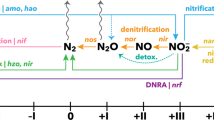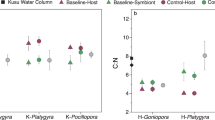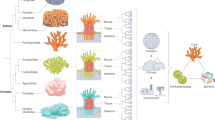Abstract
Diazotrophic bacteria are instrumental in generating biologically usable forms of nitrogen by converting abundant dinitrogen gas (N2) into available forms, such as ammonium. Although nitrogen is crucial for coral growth, direct observation of associations between diazotrophs and corals has previously been elusive. We applied fluorescence in situ hybridization (FISH) and nanoscale secondary ion mass spectrometry to observe the uptake of 15N-enriched diazotrophic Vibrio sp. isolated from Acropora millepora into conspecific coral larvae. Incorporation of Vibrio sp. cells was observed in coral larvae after 4-h incubation with enriched bacteria. Uptake was restricted to the aboral epidermis of larvae, where Vibrio cells clustered in elongated aggregations. Other bacterial associates were also observed in epidermal areas in FISH analyses. Although the fate and role of these bacteria requires additional investigation, this study describes a powerful approach to further explore cell associations and nutritional pathways in the early life stages of the coral holobiont.
Similar content being viewed by others
Log in or create a free account to read this content
Gain free access to this article, as well as selected content from this journal and more on nature.com
or
References
Ceh J, Kilburn MR, Cliff JB, Raina J-B, van Keulen M, Bourne DG . (2013). Nutrient cycling in early coral life stages: Pocillopora damicornis larvae provide their algal symbiont (Symbiodinium with nitrogen acquired from bacterial associates. Ecol Evol 3: 2393–2400.
Kimes NE, Van Nostrand JD, Weil E, Zhou J, Morris PJ . (2010). Microbial functional structure of Montastraea faveolata, an important Caribbean reef-building coral, differs between healthy and yellow-band diseased colonies. Environ Microbiol 12: 541–556.
Kopp C, Pernice M, Domart-Coulon I, Djediat C, Spangenberg J, Alexander D et al. (2013). Highly dynamic cellular-level response of symbiotic coral to a sudden increase in environmental nitrogen. MBio 4: e00052–13.
Kvennefors ECE, Roff G . (2009). Evidence of cyanobacteria-like endosymbionts in Acroporid corals from the Great Barrier Reef. Coral Reefs 28: 547.
Lema KA, Willis BL, Bourne DG . (2012). Corals form characteristic associations with symbiotic nitrogen-fixing bacteria. Appl Environ Microbiol 78: 3136–3144.
Lema KA, Bourne DG, Willis BL . (2014a). Onset and establishment of diazotrophs and other bacterial associates in the early life history stages of the coral Acropora millepora. Mol Ecol 23: 4682–4695.
Lema KA, Willis BL, Bourne DG . (2014b). Amplicon pyrosequencing reveals spatial and temporal consistency in diazotroph assemblages of the Acropora millepora microbiome. Environ Microbiol 16: 3345–3359.
Lesser MP, Mazel CH, Gorbunov MY, Falkowski PG . (2004). Discovery of symbiotic nitrogen-fixing cyanobacteria in corals. Science 305: 997–1000.
Lesser MP, Falcón LI, Rodríguez-Román A, Enríquez S, Hoegh-Guldberg O, Iglesias-Prieto R . (2007). Nitrogen fixation by symbiotic cyanobacteria provides a source of nitrogen for the scleractinian coral Montastraea cavernosa. Mar Ecol Prog Ser 346: 143–152.
Olson ND, Ainsworth TD, Gates RD, Takabayashi M . (2009). Diazotrophic bacteria associated with Hawaiian Montipora corals: diversity and abundance in correlation with symbiotic dinoflagellates. J Exp Mar Biol Ecol 371: 140–146.
Pernice M, Dunn SR, Tonk L, Dove S, Domart-Coulon I, Hoppe P et al. (2014). A nanoscale secondary ion mass spectrometry study of dinoflagellate functional diversity in reef-building corals. Environ Microbiol 17: 3570–3580.
Pernice M, Meibom A, Van Den Heuvel A, Kopp C, Domart-Coulon I, Hoegh-Guldberg O et al. (2012). A single-cell view of ammonium assimilation in coral-dinoflagellate symbiosis. ISME J 6: 1314–1324.
Santos HF, Carmo FL, Duarte G, Dini-Andreote F, Castro CB, Rosado AS et al. (2014). Climate change affects key nitrogen-fixing bacterial populations on coral reefs. ISME J 8: 2272–2279.
Shashar N, Cohen Y, Loya Y, Sar N . (1994). Nitrogen fixation (acetylene reduction) in stony corals: evidence for coral-bacteria interactions. Mar Ecol Prog Ser 111: 259–264.
Stambler N . (2011) Zooxanthellae: the yellow symbionts inside animals. In: Dubinsky Z, Stambler N (eds), Coral Reefs: An Ecosystem in Transition. Springer: Netherlands, pp 87–106.
Yellowlees D, Alwyn T, Rees V, Leggat W . (2008). Metabolic interactions between algal symbionts and invertebrate hosts. Plant Cell Environ 31: 679–694.
Acknowledgements
We thank Paul Rigby (UWA, CMCA) for his help in confocal instrumentation and analysis, and the Children’s Clinical Research Facility at the Princess Margaret Hospital of Children for providing us their facilities that allowed FISH preparations. Rong Liu is also thanked for assistance with the NanoSIMS analysis. This project was supported through an ANNiMS grant (Australian National Network in Marine Science) and The Australian Institute of Marine Sciences (AIMS). The authors acknowledge access to the Australian Microscopy and Microanalysis Research Facility at the Centre for Microscopy, Characterisation and Analysis, UWA, a facility funded by the University, State and Commonwealth Governments.
Author information
Authors and Affiliations
Corresponding author
Ethics declarations
Competing interests
The authors declare no conflict of interest.
Additional information
Supplementary Information accompanies this paper on The ISME Journal website
Supplementary information
Rights and permissions
About this article
Cite this article
Lema, K., Clode, P., Kilburn, M. et al. Imaging the uptake of nitrogen-fixing bacteria into larvae of the coral Acropora millepora. ISME J 10, 1804–1808 (2016). https://doi.org/10.1038/ismej.2015.229
Received:
Revised:
Accepted:
Published:
Issue date:
DOI: https://doi.org/10.1038/ismej.2015.229
This article is cited by
-
Presence of algal symbionts affects denitrifying bacterial communities in the sea anemone Aiptasia coral model
ISME Communications (2022)
-
Intracellular bacteria are common and taxonomically diverse in cultured and in hospite algal endosymbionts of coral reefs
The ISME Journal (2021)
-
Vibrio coralliilyticus infection triggers a behavioural response and perturbs nutritional exchange and tissue integrity in a symbiotic coral
The ISME Journal (2019)
-
Intraspecific differences in molecular stress responses and coral pathobiome contribute to mortality under bacterial challenge in Acropora millepora
Scientific Reports (2017)



